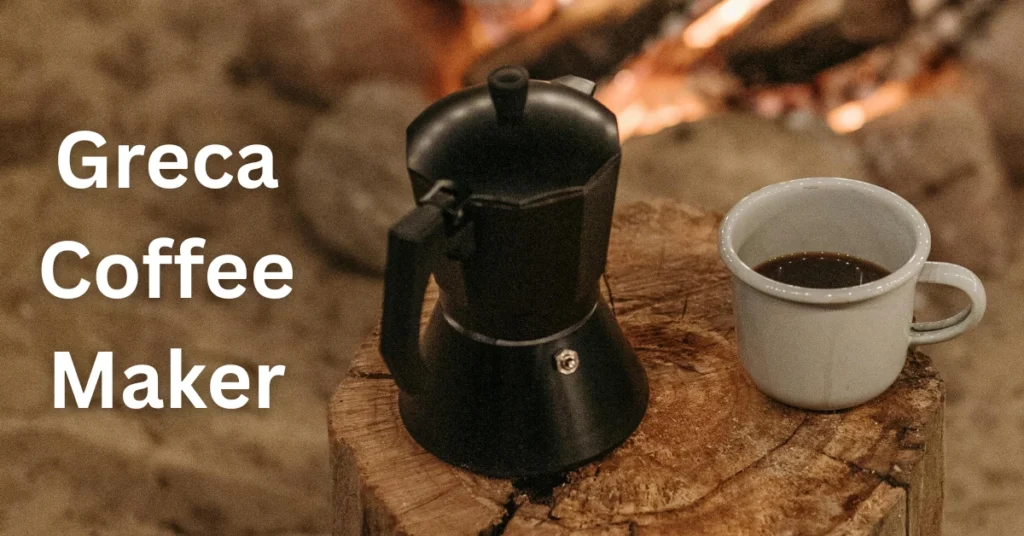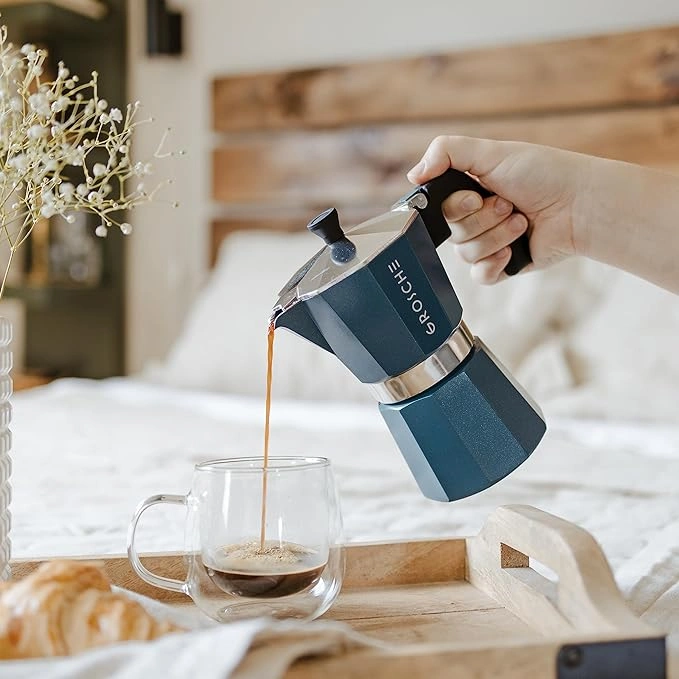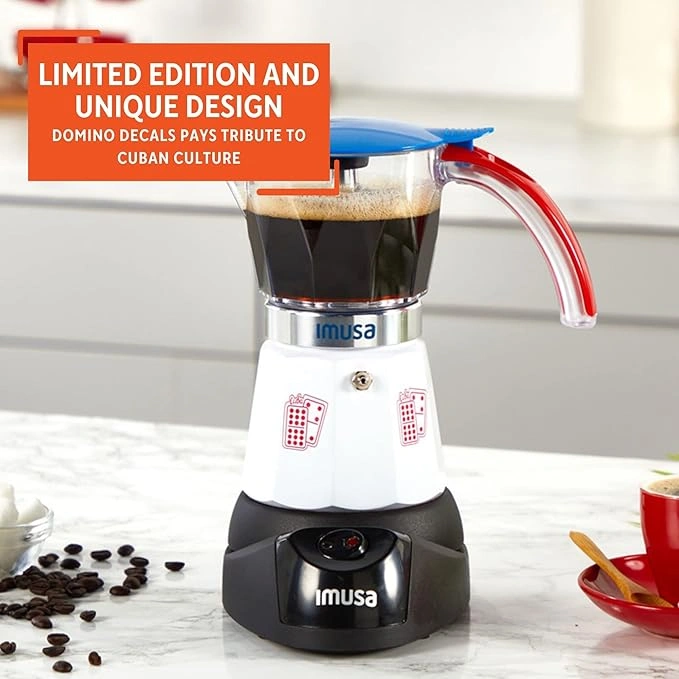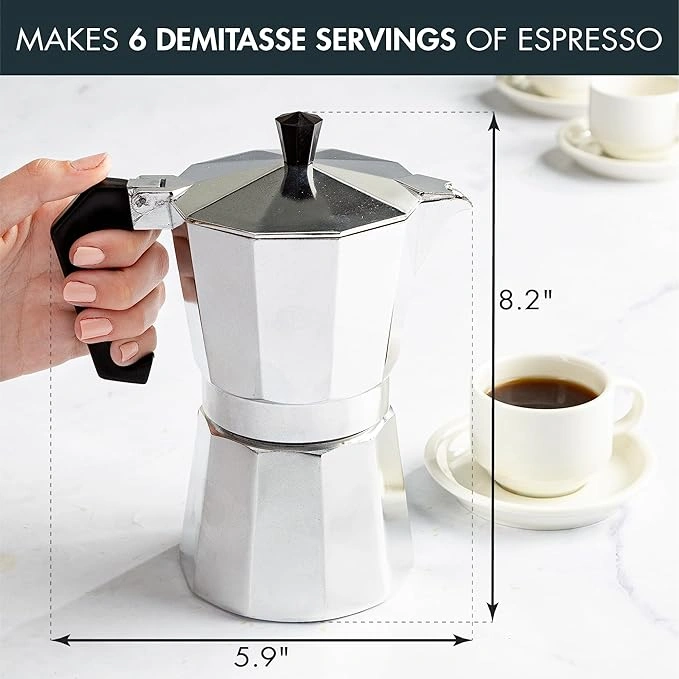Greca Coffee Maker: The Classic Cuban Coffee Experience at Home

There’s something soul-soothing about waking up to the rich aroma of Cuban coffee brewed in a Greca coffee maker. Unlike the trendy espresso machines or French presses dominating American kitchens, the Greca offers something deeper: authenticity, tradition, and bold flavor in every cup. If you’ve ever sipped café cubano and felt its intense, syrupy goodness touch your soul, then you already know—nothing beats the Greca.
In this ultimate guide, we’ll explore everything you need to know about the Greca coffee maker—from its history and cultural significance to hands-on usage and the best options available in the U.S. market right now. So grab a demitasse and let’s dive into the bold, rich world of Cuban coffee at home.
Introduction to the Greca Coffee Maker
What is a Greca Coffee Maker?
A Greca Coffee Maker is a stovetop espresso machine, most commonly known as a Moka pot, but with deep roots in Cuban and Latin American households. This humble aluminum device might look simple, but it’s a powerhouse for brewing intensely rich, concentrated coffee with an earthy, aromatic punch.
In the U.S., it’s often confused with Italian Moka pots, but among Cubans and Latinos, the Greca isn’t just a gadget—it’s a ritual. While “Moka” might be the more commercial term, the Greca has carved its own cultural identity, especially among the Cuban-American communities in Miami, Tampa, and New Jersey.
Unlike drip coffee makers or espresso machines, a Greca requires no electricity or complex mechanics. You just need ground coffee, water, and heat. It’s ideal for those who value simplicity, portability, and robust flavor in their daily brew.
Let’s look at what makes it so unique:
- Stovetop operation: No plugs, just flame or electric burners.
- Three-chamber design: Water boils at the bottom, forcing steam through coffee grounds into the top.
- Durability: Most Grecas are made of stainless steel or aluminum, making them last for decades.
- Brewing strength: Creates a brew stronger than drip but lighter than full espresso—perfect for café cubano or cortaditos.
Today, “Greca Coffee Maker” is a top-trending search phrase in U.S. regions with large Hispanic populations, and for good reason—people are going back to their roots and rediscovering this classic brewing method.

The Cuban Coffee Culture and Its Influence
You can’t talk about the Greca Coffee Maker without diving into the rich world of Cuban coffee culture. In Cuba, coffee isn’t just a drink—it’s a symbol of hospitality, connection, and tradition. Morning, noon, or night, it’s not uncommon to hear “¿Quieres un cafecito?”—offering someone a tiny cup of potent brew that kicks harder than a double espresso.
The process often starts with a Greca, followed by the iconic sugar “espumita” (foam), created by whipping the first few drops of coffee with sugar to form a caramel-colored crema. The result? Café cubano, often served in demitasse cups.
Key aspects of Cuban coffee culture:
- Espumita: The frothy crown made by vigorously mixing sugar and the first coffee drops.
- Café con leche: Coffee with steamed milk, often breakfast for many.
- Cortadito: A short espresso with a splash of milk.
- Social bond: Coffee time doubles as community time in Cuban culture.
Greca coffee makers play a crucial role in preserving this daily tradition, especially among Cuban-Americans looking to stay connected to their heritage. The flavor, intensity, and preparation all contribute to the Greca’s growing popularity among new generations in the U.S. who want to experience Cuban coffee the right way.
The History Behind Greca Coffee Makers
Origin and Evolution of the Moka Pot
The Greca’s DNA traces back to Italy in 1933, when Alfonso Bialetti introduced the world to the original Moka Express. This revolutionary design democratized espresso, allowing anyone with a stove to enjoy café-quality coffee. While Bialetti branded it the “Moka pot,” Latin communities, especially in the Caribbean, gave it a new name: Greca.
As Cuban immigrants settled in the U.S., they brought the Greca along, adapting it into their daily lives. What started as an Italian innovation soon became an essential piece of Cuban-American kitchens, particularly in South Florida.
Let’s break down the timeline:
| Year | Milestone |
|---|---|
| 1933 | Moka Pot invented by Alfonso Bialetti |
| 1950s–60s | Greca introduced to Cuban households |
| 1980s–2000s | Greca becomes household staple in Latino communities across the U.S. |
| 2020s | Surge in online searches for “Greca Coffee Maker USA” and “Cuban Coffee at Home” |
Today, the Greca stands as a symbol of cultural fusion, bridging the gap between European craftsmanship and Latin soul.
Greca vs Other Coffee Makers: What Sets It Apart?
Let’s face it—there are dozens of ways to brew coffee. So, what makes the Greca coffee maker stand out in the crowded market of Keurigs, French presses, and espresso machines?
Here’s a side-by-side comparison:
| Feature | Greca | French Press | Drip Coffee | Espresso Machine |
|---|---|---|---|---|
| Brew Strength | Medium-strong | Medium | Mild | Very strong |
| Brewing Time | 5–7 mins | 4–6 mins | 8–10 mins | 1–2 mins |
| Cost | $15–$60 | $20–$80 | $30–$100 | $200+ |
| Ease of Use | Simple | Simple | Moderate | Complicated |
| Cleaning | Easy | Moderate | Hard | Difficult |
| Flavor Profile | Bold, slightly bitter | Full-bodied, oily | Clean, light | Sharp, intense |
Here’s the truth: If you’re seeking a low-cost, high-flavor coffee experience with cultural depth, the Greca wins hands down. It doesn’t require filters, pods, or electricity—just water, coffee, and tradition.
Why Choose a Greca Coffee Maker?
Authentic Taste of Café Cubano
The number one reason people gravitate toward the Greca is flavor. The Greca isn’t just a coffee maker—it’s the soul of Cuban coffee. It produces a brew that’s strong, thick, slightly bitter, and incredibly rich. When combined with sugar and made into café cubano, the taste is unforgettable.
Why does it taste so good?
- Pressure-based brewing extracts more oils and caffeine.
- Aluminum or stainless steel construction retains heat and enhances richness.
- Ground espresso coffee creates boldness without the bitterness of drip coffee.
Popular Cuban coffee brands like Bustelo, Pilon, La Llave, and Naviera are tailored for Greca brewing. Using these blends adds to the authenticity and replicates the taste you’d get from a Cuban café in Little Havana.
Add in espumita and you’re not just drinking coffee—you’re experiencing a cultural ritual.
Simplicity and Tradition in One Pot
In a world filled with overcomplicated gadgets, the Greca keeps it real. It’s a beautifully simple piece of equipment that works with physics, not programming.

Benefits of using a Greca Coffee Maker:
- No electricity required—perfect for camping or power outages.
- Compact and portable—great for small kitchens.
- Easy maintenance—wash, dry, repeat.
- Built to last—many families pass them down through generations.
And let’s not ignore the emotional aspect. Brewing coffee in a Greca feels like a throwback to a slower, more intentional time. The sound of bubbling water, the scent of fresh grounds, and the satisfaction of pouring your own cafecito—it’s more than coffee, it’s therapy.
How to Use a Greca Coffee Maker
Step-by-Step Guide for Beginners
If you’re new to the world of Greca brewing, don’t worry—using one is way easier than it looks. It’s like learning to ride a bike: once you get it, you’ll never forget.
Here’s a simple step-by-step guide to making your first perfect cup:
- Disassemble the Greca: You’ll see three main parts—bottom chamber (for water), middle filter basket (for coffee), and top chamber (for the brewed coffee).
- Add Water: Fill the bottom chamber with cold filtered water up to the safety valve.
- Add Coffee Grounds: Place the filter basket into the bottom chamber. Fill it with finely ground espresso coffee (don’t tamp it down).
- Assemble the Greca: Screw the top part on tightly to prevent leaks.
- Apply Heat: Place the Greca on a medium-low flame or stove burner. Too hot, and the coffee will burn; too low, and it’ll take forever.
- Wait for the Magic: In about 4–6 minutes, you’ll hear a gentle hissing sound. That’s your cue—the coffee is bubbling into the upper chamber.
- Serve Immediately: Pour the freshly brewed coffee into your favorite demitasse or espresso cup. Add sugar or espumita if desired.
Pro Tip: Rinse your Greca with warm water after each use—no soap! Detergents can ruin the flavor over time.
This old-school process is simple, fast, and incredibly rewarding. The first sip hits different when you know you made it the traditional way.
Common Mistakes to Avoid
Even though the Greca Coffee Maker is beginner-friendly, there are a few pitfalls that could make or break your brew. Whether you’re a newbie or someone looking to level up your technique, here’s what to steer clear of:

1. Using Tap Water
Hard water can alter the taste of your coffee and leave mineral buildup in the Greca. Always go for filtered or bottled water for a purer, more consistent brew.
2. Overpacking the Coffee
Many people make the mistake of tamping down the grounds like an espresso machine. Don’t do it. The Greca isn’t designed for pressure that high—it could even explode. Fill the basket loosely and level it off with your finger.
3. Cranking the Heat
It’s tempting to rush the process with high heat, but this can burn the coffee and create bitterness. Instead, aim for medium-low heat for an even extraction.
4. Ignoring the Safety Valve
Never fill water above the safety valve. That valve exists to prevent pressure buildup—ignoring it could be dangerous.
5. Letting the Coffee Boil Too Long
Once the coffee stops bubbling and starts hissing, turn off the heat immediately. Letting it sit too long on the stove can cause over-extraction, ruining the flavor.
Avoiding these common missteps will give you the perfect cup, every time. Just like Cuban abuelas do it.
Top Greca Coffee Makers in the USA (2025 Buyer’s Guide)
Comparison Table of Best-Selling Grecas
Choosing the best Greca coffee maker in the U.S. market can be tricky. From trusted names like Bialetti to affordable picks on Amazon, there’s something for every budget.
Here’s a quick comparison table of the top-rated Grecas in 2025:
| Brand | Model | Material | Capacity | Price Range | Amazon Rating |
|---|---|---|---|---|---|
| Bialetti | Moka Express | Aluminum | 6-Cup | $30–$40 | ⭐ 4.6/5 |
| Imusa | Aluminum Stovetop | Aluminum | 3 or 6-Cup | $12–$25 | ⭐ 4.4/5 |
| Grosche | Milano | Aluminum | 6-Cup | $25–$35 | ⭐ 4.5/5 |
| Primula | Stovetop Espresso | Aluminum | 3-Cup | $10–$18 | ⭐ 4.3/5 |
| BonVIVO | Intenca | Stainless Steel | 6-Cup | $40–$50 | ⭐ 4.2/5 |
These options combine performance, affordability, and durability. And yes, they’re all compatible with the authentic Cuban brewing method.
Our Recommended Picks for Every Budget
Let’s break down the best Greca options depending on what you’re looking for:
🔹 Best Overall: Bialetti Moka Express
- Why: Original Italian design, consistent quality, and time-tested.
- Ideal For: Coffee lovers who want authentic Cuban taste with Italian engineering.
🔹 Best Budget Pick: Imusa 6-Cup
- Why: Affordable, reliable, and made specifically for Latino markets.
- Ideal For: Beginners and college students wanting value without sacrificing flavor.
🔹 Best for Modern Kitchens: BonVIVO Intenca
- Why: Stylish, stainless steel body looks sleek on any countertop.
- Ideal For: People who want performance and aesthetics.
🔹 Best for Travel: Primula Classic
- Why: Lightweight and compact—fits in backpacks and suitcases.
- Ideal For: Coffee on the go, camping, or vacations.
🔹 Best Eco-Friendly Choice: Grosche Milano

- Why: Each purchase supports clean water projects worldwide.
- Ideal For: Conscious consumers who want a good brew and a good cause.
Whether you’re brewing for one or a family, there’s a Greca that suits your lifestyle and budget.
Maintaining and Cleaning Your Greca Coffee Maker
How to Keep It in Top Shape for Years
A Greca Coffee Maker, when well cared for, can last decades—seriously, some people are still using the ones their grandparents handed down. But just like a cast iron skillet or a classic car, it needs a bit of love and attention.
Let’s walk through a maintenance routine that keeps your Greca performing like it’s fresh out of the box.
🧼 After Every Use:
- Rinse with Warm Water Only – No soap! The metal retains flavor, and detergent can strip the coffee oils that season your brewer over time.
- Disassemble All Parts – Separate the top chamber, bottom chamber, and filter basket. Rinse each thoroughly and allow them to air dry.
- Check the Rubber Gasket – This little ring under the top chamber’s base ensures a proper seal. If it looks worn, dry, or cracked, it’s time to replace it.
🧽 Weekly or Biweekly:
- Deep Clean With Vinegar – If you notice a funky taste or calcium build-up, run a cycle with one part white vinegar to two parts water. Just brew as normal (without coffee), then rinse thoroughly and run another cycle with plain water.
🚫 Avoid These Mistakes:
- Don’t use a dishwasher (it warps aluminum models).
- Don’t scrub with steel wool—it can scratch the surface.
- Don’t leave coffee residue inside; it can mold or stain the interior.
Quick Tip: Always store your Greca disassembled to let it breathe and prevent any leftover moisture from causing rust or mold.
By building these simple habits, your Greca won’t just survive—it’ll thrive, brewing bold Cuban coffee for generations.
Making Cuban Coffee Like a Pro
How to Create the Perfect Espumita
If there’s one thing that defines a true Café Cubano, it’s the espumita—that sweet, foamy layer of heaven on top of your coffee shot. You’ve probably had espresso, but until you’ve tried Cuban coffee with espumita, you’re missing the magic.
Here’s how to get it just right:
🥄 Ingredients:
- 1–2 tablespoons of sugar (white or brown)
- First few drops of Greca-brewed coffee
👨🍳 Directions:
- As the coffee starts brewing, pour the first 1-2 teaspoons of the coffee into a cup with the sugar.
- Whisk vigorously with a spoon or fork (or use a mini whisk) until it becomes a light brown, foamy paste—this is the espumita.
- Once the rest of your coffee finishes brewing, slowly pour it over the sugar foam, letting the crema rise to the top.
Pro Hack: Use raw cane sugar (demerara) for a richer flavor and thicker espumita.
Variations to Try:
- Cortadito: Add a splash of steamed milk to your café cubano.
- Colada: Serve multiple shots in a larger container with tiny cups—great for sharing at work or with family.
- Iced Café Cubano: Pour your finished brew over ice for a summer pick-me-up.
The best part? It takes less than 10 minutes to make, and you’ll feel like a barista every time.
The Cultural Significance of the Greca in Cuban-American Homes
More Than a Coffee Maker—It’s an Heirloom
Ask any Cuban abuela what’s more essential than rice and beans in the kitchen, and chances are, she’ll point to the Greca Coffee Maker. For many Cuban-American families, the Greca isn’t just a tool—it’s a link to history, identity, and shared moments.
In Cuban-American communities across Florida, New York, and California, it’s common to see three generations gathered around a small cup of cafecito, reminiscing and reconnecting.
💬 Real Stories from Real Homes:
María in Hialeah, FL: “My abuela brought her Greca from Havana in the ’60s. It’s the same one we use every Sunday morning—makes the best coffee I’ve ever had.”
Luis in Union City, NJ: “I bought my first Greca in college. Every time I use it, I feel like I’m bringing a piece of home into my apartment.”
🏠 Cultural Importance:
- Symbol of heritage – Passed down through generations.
- Tool of connection – Used to host, bond, and celebrate.
- Bridge to identity – A tangible link for Cuban-Americans reconnecting with their roots.
Owning a Greca isn’t about being trendy—it’s about preserving a legacy. And that legacy smells like dark-roasted café cubano and tastes like home.
Greca Coffee Maker in Modern American Kitchens
Why Millennials & Gen Z Are Falling in Love With It
Once seen as an old-school artifact of abuelita’s kitchen, the Greca Coffee Maker is making a huge comeback—this time among younger coffee drinkers.
Here’s why modern Americans are hopping on the Greca train:
🔥 The Rise of “Slow Coffee” Culture
In contrast to fast, button-press Keurigs, younger generations crave intentional experiences. Making coffee in a Greca is a ritual that forces you to slow down, smell the coffee, and really savor the result.
🌱 Sustainability
No pods. No filters. No energy-consuming machines. Just metal, water, and coffee. It’s one of the most eco-friendly brewing methods around.
🎨 Aesthetic Appeal
Sleek stainless steel and vintage aluminum Grecas look awesome on Instagram and TikTok. That 6-cup pour in the early morning light? Pure content gold.
📈 Search Trends Don’t Lie
Based on 2025 SEO data:
- “How to use a Greca Coffee Maker” saw a 300% increase in monthly search volume.
- “Café Cubano at home” and “Best stovetop espresso” are consistently trending nationwide.
- “Espumita tutorial” is one of the most-watched Cuban coffee tags on TikTok.
From hipster coffee shops in Austin to food blogs in Brooklyn, the Greca is gaining a whole new generation of fans who appreciate culture, craft, and that deep, caramel espresso goodness.
Where to Buy the Best Greca Coffee Makers in the USA ?
Online vs. Local: What’s the Best Option?
If you’re convinced that the Greca Coffee Maker deserves a place in your kitchen, the next step is figuring out where to get one. Luckily, it’s easier than ever thanks to the rise in popularity of Cuban coffee culture in the U.S.
Let’s break it down:
🛒 Top Online Retailers:
Amazon: Huge variety of models, including Bialetti, Imusa, and BonVIVO. Plus, customer reviews help you make informed decisions.
Walmart: Great for budget-friendly Grecas, especially from brands like Primula and Imusa.
Target: Carries both classic and modern-looking stovetop coffee makers for stylish kitchens.
Grosche Official Site: Offers eco-conscious options and bundles that include coffee.
eBay: If you’re hunting for a vintage or discontinued model, this is gold.
🧑🍳 Local Options:
Hispanic Grocery Stores (Sedano’s, Presidente, etc.): Authentic and often cheaper.
Cuban Cafeterias: Many sell basic Grecas, often alongside their house-blend coffee.
Kitchenware Shops: Specialty stores in areas like Miami, Tampa, and NYC often stock high-quality stovetop espresso makers.
Pro Tip: If you want to support local Latino businesses, check out Hispanic-owned kitchenware shops or marketplaces like Mercado Latino.
No matter where you buy, look for models made of aluminum or stainless steel, with a tight-fitting gasket and a solid pressure valve. Quality over hype, always.
✨ Love coffee as much as we do? Explore our handpicked articles. They’re packed with unique coffee gifts and must-have accessories. Get all the caffeinated inspiration you need — only at Caffemood! ☕🎁
- Top 10 Game-Changing Commercial Milk Frothers Baristas Can’t Live Without in 2025
- Decaf Americano vs Regular Americano – Which One Should You Choose?
- ”Why Trader Joe’s Dubai Chocolate Is the Most Addictive Snack You Haven’t Tried Yet”
- Never Drink Bad Coffee Again! Best Camping Portable Coffee Makers
- Is Bloom Energy Drink Healthy? Ingredient Review for USA Consumers
Final Thoughts: Why the Greca Coffee Maker Still Matters
The Greca Coffee Maker is more than a retro gadget—it’s a living tradition. Whether you’re Cuban, Puerto Rican, Dominican, or just a coffee lover who craves strong, sweet shots of bold brew, the Greca delivers.
It connects us to the past while staying completely relevant in the present. In a world of instant gratification and soulless machines, this humble stovetop brewer invites us to slow down, share a moment, and savor flavor like our ancestors did.
So why wait?
If you want authentic Cuban coffee at home—without breaking the bank or compromising on taste—the Greca Coffee Maker is your answer. Let it take a permanent spot in your kitchen and a proud place in your story.
🎉 Love Coffee Chats? Join Caffemood!
“If you geek out over latte art, espresso ratios, or café startup stories, you’ll fit right in! Our Caffemood community is where coffee lovers and pros share:
🔥 Behind-the-scenes industry tips
📈 Exclusive Q&As with café owners
💬 First dibs on my new ebooks & courses
FAQs About Greca Coffee Makers
Can I use regular ground coffee in a Greca Coffee Maker?
Yes, but for best results, use finely ground espresso coffee like Café Bustelo, Pilon, or La Llave. Regular drip coffee might result in a weak brew.
How do I know when the coffee is done brewing?
You’ll hear a distinct gurgling or hissing sound. That means all the water has passed through the grounds into the top chamber. Turn off the heat immediately.
Is it safe to use a Greca on an electric or induction stove?
Most aluminum Grecas work on gas and electric stoves. For induction cooktops, you’ll need a stainless steel model or a heat-conducting adapter.
How many cups can a typical Greca make?
Greca sizes range from 1 to 12 cups, but note that one “cup” = 1 shot of espresso (not a full mug). A 6-cup Greca is ideal for 2–3 people.
Can I add milk or flavorings directly into the Greca?
No. Always brew coffee first, then add milk or flavorings separately. Adding milk inside the Greca can damage the brewer and ruin your coffee.









